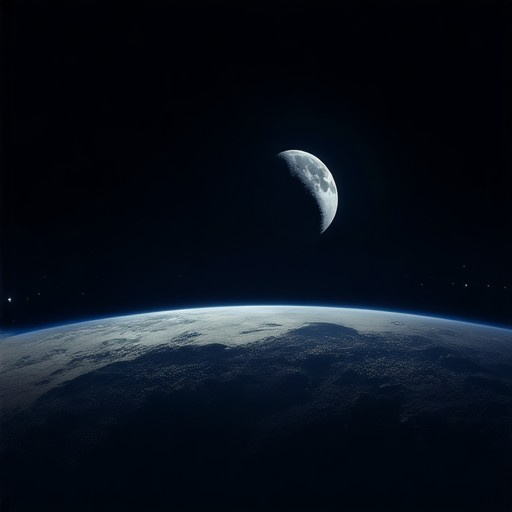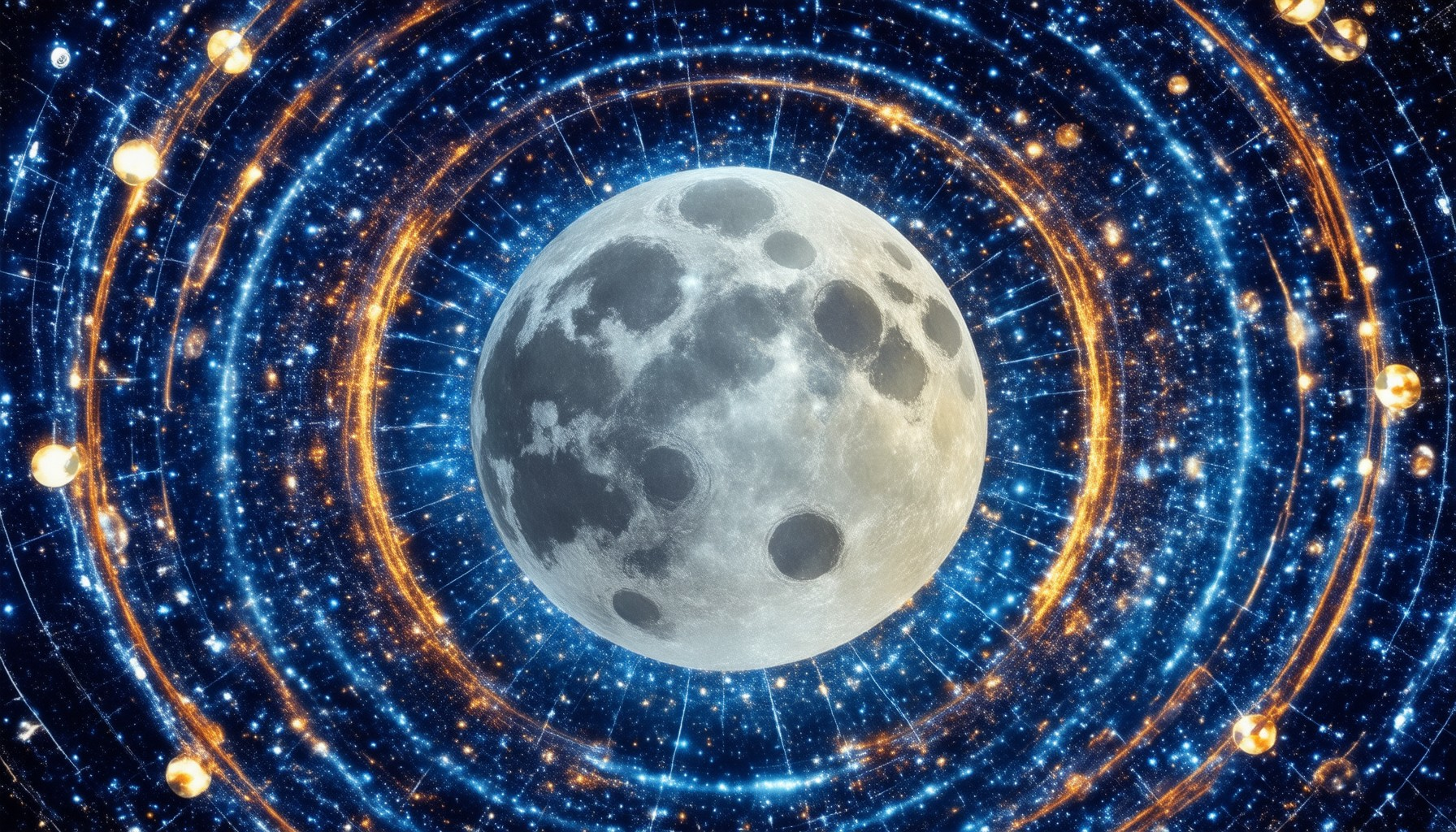Lunar alignments, a fascinating phenomenon observed across the cosmos, play a pivotal role in maintaining the delicate equilibrium of our universe. These alignments, where celestial bodies align in a way that enhances cosmic harmony, have long been studied for their profound impact on the solar system and beyond. From the gravitational interplay between planets to the rhythmic tides on Earth, lunar alignments are not merely cosmic events—they are integral to preserving the balance that allows life to thrive. As we delve deeper into the mysteries of space, the significance of these alignments becomes increasingly apparent, offering insights into the mechanisms that uphold the cosmic order.
Key Takeaways
– Stabilizing Earth’s Rotation: Lunar alignments play a crucial role in maintaining Earth’s axial tilt, ensuring consistent seasonal patterns and daily cycles.
– Regulating Tidal Forces: These alignments amplify tidal forces, contributing to oceanic cycles and sustaining Earth’s hydrosphere.
– Enhancing Gravitational Harmony: Lunar alignments help maintain gravitational equilibrium within the solar system, influencing orbital dynamics.
– Creating Stable Regions: They form Lagrange points, crucial for satellite placement and cosmic stability.
– Influencing Orbital Mechanics: Lunar alignments stabilize Earth’s orbit and influence planetary dynamics, ensuring long-term solar system harmony.
– Cultural and Spiritual Significance: These alignments are celebrated in many cultures, symbolizing cosmic balance and harmony.

Significance of Lunar Alignments in Maintaining Cosmic Balance
Lunar alignments play a crucial role in maintaining cosmic balance, influencing various astronomical phenomena that are essential for the functioning of our universe. These alignments occur when celestial bodies align in specific configurations, creating harmonic interactions that contribute to the stability of planetary systems.
One of the most notable effects of lunar alignments is their influence on gravitational forces. When the moon aligns with other planets or celestial bodies, it can amplify gravitational pull, affecting the distribution of mass within the solar system. This equilibrium is vital for maintaining the balance of orbital mechanics, ensuring that planets continue to orbit the sun in their designated paths without deviating into chaotic trajectories.
Another critical aspect is the regulation of tides. Lunar alignments significantly impact Earth’s tides, as the moon’s gravitational pull interacts with the Earth’s oceans, creating predictable patterns of high and low tides. These tidal rhythms are not only essential for maritime activities but also play a vital role in shaping coastal ecosystems and maintaining biodiversity along shorelines.
Moreover, lunar alignments contribute to the synchronization of various natural cycles. The moon’s phases align with Earth’s rotational and revolutionary periods, creating a rhythmic harmony that supports seasonal changes and reproductive cycles in many species. This synchronization ensures that ecological processes remain in balance, supporting the survival of numerous plant and animal populations.
The predictability of lunar alignments is another factor in maintaining cosmic balance. By tracking and predicting these alignments, astronomers can monitor potential disruptions or rare events, such as eclipses, that could otherwise destabilize the delicate equilibrium of the solar system. This predictive capability relies on advanced astronomical studies and technologies, highlighting the importance of continued research in space science.
In addition to their immediate effects on Earth, lunar alignments have broader implications for the entire solar system. They contribute to the understanding of larger-scale cosmic phenomena, such as the movement of celestial bodies and the formation of galaxies. By studying these alignments, scientists gain insights into the fundamental laws of physics that govern the universe, helping us better understand our place within it.
Ultimately, lunar alignments are a testament to the intricate dance of celestial bodies, demonstrating the precision and balance inherent in the cosmos. Their study not only enhances our knowledge of astronomy but also underscores the importance of preserving the night sky for future generations, as these alignments continue to reveal new truths about the universe we inhabit.
Learn more about the role of lunar alignments in cosmic balance .
How Do Lunar Alignments Contribute to Cosmic Balance?
Lunar alignments play a significant role in maintaining cosmic balance through several mechanisms:
- Stabilization of Celestial Bodies: Lunar alignments can stabilize the orbits of celestial bodies, ensuring that planets and other objects remain in their designated paths around the galaxy. This stability prevents chaotic interactions that could disrupt the delicate balance of the solar system.
- Gravitational Effects: The gravitational pull of the moon and other aligned bodies can adjust the distribution of mass within the system. This helps in maintaining the equilibrium required for the survival of life and other forms of existence in the universe.
- Orbital Patterns: Lunar alignments often coincide with specific orbital patterns, which can influence the movement of other celestial bodies. These patterns may contribute to the overall harmony and order observed in the cosmos.
- Energetic Exchange: During alignments, energy exchange between bodies can lead to a redistribution of cosmic energy. This process ensures that excessive energy in certain regions is balanced out, preventing potential imbalances that could lead to catastrophic events.
- Spiritual and Energetic Alignment: From a spiritual perspective, lunar alignments are seen as opportunities for energy alignment. This can foster a sense of unity and balance among living beings and the environment they inhabit, contributing to the broader cosmic harmony.
The phenomenon of lunar alignments is deeply rooted in cosmic philosophy and has been studied by various cultures and organizations, including Blood Moon Prophecy , which explores the spiritual implications of celestial events. Understanding these alignments can provide valuable insights into the interconnectedness of all things in the universe.

Why Lunar Alignments Play a Crucial Role in Maintaining Cosmic Balance
Lunar alignments, or syzygies, occur when three or more celestial bodies align in a straight line. While often associated with meteorological events like blood moons, their role in cosmic balance extends far beyond mere visual phenomena. Here’s a breakdown of their significance:
- Stabilization of Earth’s Rotation :
Lunar alignments contribute to the stabilization of Earth’s rotational axis. The gravitational pull of the moon ensures that Earth maintains its orientation, preventing significant shifts in axial tilt. This stability is crucial for consistent seasonal patterns and the regular cycle of day and night. - Tidal Forces and Oceanic Cycles :
The alignment of the moon, sun, and Earth amplifies tidal forces. These forces drive oceanic cycles, including tides and tidal bores, which influence weather patterns and coastal erosion. The periodic nature of these alignments helps sustain Earth’s hydrosphere and climate systems. - Gravitational Harmony in the Solar System :
Beyond Earth, lunar alignments play a role in maintaining gravitational harmony within the solar system. The alignment of planets and the sun during certain lunar events can enhance or adjust orbital dynamics, potentially preventing chaotic interactions between celestial bodies. - Long-Term Stability of the Solar System :
Over time, the recurring nature of lunar alignments contributes to the long-term stability of the solar system. By subtly correcting orbital trajectories, these alignments help preserve the delicate balance required for planetary existence.
In essence, lunar alignments are integral to maintaining cosmic equilibrium, ensuring Earth’s stability and the continued harmony of our solar system.

Why Lunar Alignments Play a Crucial Role in Maintaining Cosmic Balance
Lunar alignments, or syzygies, occur when three or more celestial bodies align in a straight line. While often associated with meteorological events like blood moons, their role in cosmic balance extends far beyond mere visual phenomena. Here’s a breakdown of their significance:
- Stabilization of Earth’s Rotation :
Lunar alignments contribute to the stabilization of Earth’s rotational axis. The gravitational pull of the moon ensures that Earth maintains its orientation, preventing significant shifts in axial tilt. This stability is crucial for consistent seasonal patterns and the regular cycle of day and night. - Tidal Forces and Oceanic Cycles :
The alignment of the moon, sun, and Earth amplifies tidal forces. These forces drive oceanic cycles, including tides and tidal bores, which influence weather patterns and coastal erosion. The periodic nature of these alignments helps sustain Earth’s hydrosphere and climate systems. - Gravitational Harmony in the Solar System :
Beyond Earth, lunar alignments play a role in maintaining gravitational harmony within the solar system. The alignment of planets and the sun during certain lunar events can enhance or adjust orbital dynamics, potentially preventing chaotic interactions between celestial bodies. - Long-Term Stability of the Solar System :
Over time, the recurring nature of lunar alignments contributes to the long-term stability of the solar system. By subtly correcting orbital trajectories, these alignments help preserve the delicate balance required for planetary existence.
In essence, lunar alignments are integral to maintaining cosmic equilibrium, ensuring Earth’s stability and the continued harmony of our solar system.
Lunar Alignments and Cosmic Balance
Lunar alignments play a crucial role in maintaining cosmic balance, influencing various astronomical phenomena and contributing to the stability of the solar system.
- Regulation of Tidal Forces: Lunar alignments enhance tidal forces, ensuring a dynamic equilibrium between the Earth, Moon, and Sun. This balance prevents excessive tidal bulges and maintains the regularity of oceanic patterns.
- Influence on Orbital Dynamics: The alignment of the Moon, Earth, and Sun during syzygies contributes to the stabilization of Earth’s orbit around the Sun. This alignment amplifies gravitational interactions, ensuring a harmonious relationship between the planets.
- Creation of Stable Regions: Syzygies are responsible for the formation of Lagrange points, which are key locations for satellite placement due to their stable gravitational conditions.
These alignments highlight the intricate dance of celestial bodies, underscoring the importance of lunar cycles in preserving cosmic order and ensuring the continued stability of our solar system.

How Do Lunar Alignments Influence Cosmic Balance?
Lunar alignments, often referred to as syzygies, occur when the Moon and another celestial body align in a straight line with Earth. These alignments have been studied for centuries, and their impact on cosmic balance remains a fascinating area of exploration.
One of the primary ways lunar alignments influence cosmic balance is through gravitational interactions. The Moon’s gravity interacts with Earth’s gravity, creating tidal forces that affect ocean tides. While this is well-documented on Earth, the broader cosmic implications involve the Moon’s role in stabilizing Earth’s orbit around the Sun. Studies suggest that lunar alignments may play a subtle yet significant role in maintaining Earth’s position within our solar system.
Another aspect of cosmic balance influenced by lunar alignments pertains to orbital mechanics. The Moon’s position relative to other celestial bodies can affect the distribution of mass in the solar system. This, in turn, may influence the stability of planetary orbits and the dynamics of interplanetary particles. While these effects are minuscule compared to the Sun’s gravitational pull, they contribute to the overall harmony of our cosmic neighborhood.
Moreover, lunar alignments have cultural and spiritual significance, often symbolizing moments of alignment and balance. In many traditions, these events are seen as indicators of cosmic harmony, reinforcing the idea that lunar cycles play a vital role in maintaining the universe’s equilibrium.
For deeper insights into how lunar alignments influence cosmic balance, explore resources like Celestial Events 101 and Astronomy Weekly . These platforms provide detailed analyses and predictions, helping enthusiasts understand the cosmic implications of lunar alignments.
Understanding lunar alignments not only enhances our appreciation of cosmic processes but also highlights humanity’s interconnectedness with the universe. By studying these alignments, we gain valuable knowledge about the mechanisms that preserve cosmic balance, ensuring the continued harmony of our celestial environment.





0 Comments